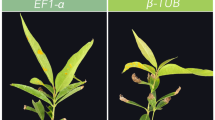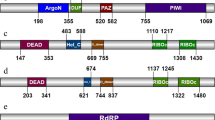Abstract
Aggressive fungal pathogens such as Botrytis and Verticillium spp. cause severe crop losses worldwide. We recently discovered that Botrytis cinerea delivers small RNAs (Bc–sRNAs) into plant cells to silence host immunity genes. Such sRNA effectors are mostly produced by Botrytis cinerea Dicer-like protein 1 (Bc-DCL1) and Bc-DCL2. Here we show that expressing sRNAs that target Bc-DCL1 and Bc-DCL2 in Arabidopsis and tomato silences Bc-DCL genes and attenuates fungal pathogenicity and growth, exemplifying bidirectional cross-kingdom RNAi and sRNA trafficking between plants and fungi. This strategy can be adapted to simultaneously control multiple fungal diseases. We also show that Botrytis can take up external sRNAs and double-stranded RNAs (dsRNAs). Applying sRNAs or dsRNAs that target Botrytis DCL1 and DCL2 genes on the surface of fruits, vegetables and flowers significantly inhibits grey mould disease. Such pathogen gene-targeting RNAs represent a new generation of environmentally friendly fungicides.
This is a preview of subscription content, access via your institution
Access options
Subscribe to this journal
Receive 12 digital issues and online access to articles
$119.00 per year
only $9.92 per issue
Buy this article
- Purchase on Springer Link
- Instant access to full article PDF
Prices may be subject to local taxes which are calculated during checkout






Similar content being viewed by others
References
Ghildiyal, M. & Zamore, P. D. Small silencing RNAs an expanding universe. Nat. Rev. Genet. 10, 94–108 (2009).
Baulcombe, D. RNA silencing in plants. Nature 431, 356–363 (2004).
Vaucheret, H. Plant ARGONAUTES. Trends Plant Sci. 13, 350–358 (2008).
Hutvagner, G. & Simard, M. J. Argonaute proteins: key players in RNA silencing. Nat. Rev. Mol. Cell Biol. 9, 22–32 (2008).
Weiberg, A. et al. Fungal small RNAs suppress plant immunity by hijacking host RNA interference pathways. Science 342, 118–123 (2013).
Weiberg, A. & Jin, H. L. Small RNAs – the secret agents in the plant-pathogen interactions. Curr. Opin. Plant Biol. 26, 87–94 (2015).
Weiberg, A., Wang, M., Bellinger, M. & Jin, H. Small RNAs: a new paradigm in plant-microbe interactions. Annu. Rev. Phytopathol. 52, 495–516 (2014).
Buck, A. H. et al. Exosomes secreted by nematode parasites transfer small RNAs to mammalian cells and modulate innate immunity. Nat. Commun. 5, 5488 (2014).
Cheng, G. F., Luo, R., Hu, C., Cao, J. & Jin, Y. X. Deep sequencing-based identification of pathogen-specific microRNAs in the plasma of rabbits infected with Schistosoma japonicum. Parasitology 140, 1751–1761 (2013).
Garcia-Silva, M. R. et al. Extracellular vesicles shed by Trypanosoma cruzi are linked to small RNA pathways, life cycle regulation, and susceptibility to infection of mammalian cells. Parasitol. Res. 113, 285–304 (2014).
Zamanian, M. et al. Release of small RNA-containing exosome-like vesicles from the human filarial parasite Brugia malayi. PLoS Negl. Trop. Dis. 9, e0004069 (2015).
Quintana, J. F. et al. Extracellular Onchocerca-derived small RNAs in host nodules and blood. Parasit Vectors 8, 58 (2015).
Baum, J. A. et al. Control of coleopteran insect pests through RNA interference. Nat. Biotechnol. 25, 1322–1326 (2007).
Mao, Y. B. et al. Silencing a cotton bollworm P450 monooxygenase gene by plant-mediated RNAi impairs larval tolerance of gossypol. Nat. Biotechnol. 25, 1307–1313 (2007).
Huang, G. Z., Allen, R., Davis, E. L., Baum, T. J. & Hussey, R. S. Engineering broad root-knot resistance in transgenic plants by RNAi silencing of a conserved and essential root-knot nematode parasitism gene. Proc. Natl. Acad. Sci. USA 103, 14302–14306 (2006).
Li, J., Todd, T. C., Oakley, T. R., Lee, J. & Trick, H. N. Host-derived suppression of nematode reproductive and fitness genes decreases fecundity of Heterodera glycines Ichinohe. Planta 232, 775–785 (2010).
Nowara, D. et al. HIGS: Host-Induced gene silencing in the obligate biotrophic fungal pathogen Blumeria graminis. Plant Cell 22, 3130–3141 (2010).
Koch, A. et al. Host-induced gene silencing of cytochrome P450 lanosterol C14 alpha-demethylase-encoding genes confers strong resistance to Fusarium species. Proc. Natl. Acad. Sci. USA 110, 19324–19329 (2013).
Jahan, S. N. et al. Plant-mediated gene silencing restricts growth of the potato late blight pathogen Phytophthora infestans. J. Exp. Bot. 66, 2785–2794 (2015).
Vega-Arreguin, J. C., Jalloh, A., Bos, J. I. & Moffett, P. Recognition of an Avr3a homologue plays a major role in mediating nonhost resistance to Phytophthora capsici in Nicotiana species. Mol. Plant Microbe Interact. 27, 770–780 (2014).
Nunes, C. C. & Dean, R. A. Host-induced gene silencing: a tool for understanding fungal host interaction and for developing novel disease control strategies. Mol. Plant Pathol. 13, 519–529 (2012).
Williamson, B., Tudzynsk, B., Tudzynski, P. & van Kan, J. A. L. Botrytis cinerea: the cause of grey mould disease. Mol. Plant Pathol. 8, 561–580 (2007).
van Kan, J. A. L. Licensed to kill: the lifestyle of a necrotrophic plant pathogen. Trends Plant Sci. 11, 247–253 (2006).
Fradin, E. F. & Thomma, B. P. Physiology and molecular aspects of Verticillium wilt diseases caused by V. dahliae and V. albo-atrum. Mol. Plant Pathol. 7, 71–86 (2006).
Klosterman, S. J., Atallah, Z. K., Vallad, G. E. & Subbarao, K. V. Diversity, pathogenicity, and management of Verticillium species. Annu. Rev. Phytopathol. 47, 39–62 (2009).
Pliego, C. et al. Host-Induced gene silencing in barley powdery mildew reveals a class of ribonuclease-like effectors. Mol. Plant Microbe Interact. 26, 633–642 (2013).
Whigham, E. et al. Broadly conserved fungal effector BEC1019 suppresses host cell death and enhances pathogen virulence in powdery mildew of barley (Hordeum vulgare L.). Mol. Plant Microbe Interact. 28, 968–983 (2015).
Panwar, V., McCallum, B. & Bakkeren, G. Host-induced gene silencing of wheat leaf rust fungus Puccinia triticina pathogenicity genes mediated by the Barley stripe mosaic virus. Plant Mol. Biol. 81, 595–608 (2013).
Ghag, S. B., Shekhawat, U. K. & Ganapathi, T. R. Host-induced post-transcriptional hairpin RNA-mediated gene silencing of vital fungal genes confers efficient resistance against Fusarium wilt in banana. Plant Biotechnol. J. 12, 541–553 (2014).
Cheng, W. et al. Host-induced gene silencing of an essential chitin synthase gene confers durable resistance to Fusarium head blight and seedling blight in wheat. Plant Biotechnol. J. 13, 1335–1345 (2015).
Sanju, S. et al. Host-mediated gene silencing of a single effector gene from the potato pathogen Phytophthora infestans imparts partial resistance to late blight disease. Funct. Integr. Genomics 15, 697–706 (2015).
Lee, H. C. et al. Diverse pathways generate microRNA-like RNAs and dicer-independent small interfering RNAs in fungi. Mol. Cell 38, 803–814 (2010).
Jin, H. L. & Zhu, J. K. How many ways are there to generate small RNAs? Mol. Cell 38, 775–777 (2010).
Helliwell, C. A. & Waterhouse, P. M. Constructs and methods for hairpin RNA-mediated gene silencing in plants. Methods Enzymol. 392, 24–35 (2005).
Liu, Y. L., Schiff, M. & Dinesh-Kumar, S. P. Virus-induced gene silencing in tomato. Plant J. 31, 777–786 (2002).
Song, J. Q. et al. Gene RB cloned from Solanum bulbocastanum confers broad spectrum resistance to potato late blight. Proc. Natl Acad. Sci. USA 100, 9128–9133 (2003).
Winston, W. M., Sutherlin, M., Wright, A. J., Feinberg, E. H. & Hunter, C. P. Caenorhabditis elegans SID-2 is required for environmental RNA interference. Proc. Natl Acad. Sci. USA 104, 10565–10570 (2007).
Whangbo, J. S. & Hunter, C. P. Environmental RNA interference. Trends Genet. 24, 297–305 (2008).
McEwan, D. L., Weisman, A. S. & Huntert, C. P. Uptake of extracellular double-Stranded RNA by SID-2. Mol. Cell 47, 746–754 (2012).
Feinberg, E. H. & Hunter, C. P. Transport of dsRNA into cells by the transmembrane protein SID-1. Science 301, 1545–1547 (2003).
Ivashuta, S. et al. Environmental RNAi in herbivorous insects. RNA 21, 840–850 (2015).
San Miguel, K. & Scott, J. G. The next generation of insecticides: dsRNA is stable as a foliar-applied insecticide. Pest Manage. Sci. 72, 801–809 (2016).
Baulcombe, D. C. VIGS, HIGS and FIGS: small RNA silencing in the interactions of viruses or filamentous organisms with their plant hosts. Curr. Opin. Plant Biol. 26, 141–146 (2015).
Govindarajulu, M., Epstein, L., Wroblewski, T. & Michelmore, R. W. Host-induced gene silencing inhibits the biotrophic pathogen causing downy mildew of lettuce. Plant Biotechnol. J. 13, 875–883 (2015).
Saleh, M. C. et al. The endocytic pathway mediates cell entry of dsRNA to induce RNAi silencing. Nat. Cell Biol. 8, 793–802 (2006).
Bolognesi, R. et al. Characterizing the mechanism of action of double-stranded RNA activity against western corn rootworm (Diabrotica virgifera virgifera LeConte). PLoS ONE 7, e47534 (2012).
Ellendorff, U., Fradin, E. F., de Jonge, R. & Thomma, B. P. H. J. RNA silencing is required for Arabidopsis defence against Verticillium wilt disease. J. Exp. Bot. 60, 591–602 (2009).
Zhang, X. et al. Arabidopsis argonaute 2 regulates innate immunity via miRNA393(*)-mediated silencing of a Golgi-localized SNARE gene, MEMB12. Mol. Cell 42, 356–366 (2011).
Hinas, A., Wright, A. J. & Hunter, C. P. SID-5 Is an endosome-associated protein required for efficient systemic RNAi in C. elegans. Curr. Biol. 22, 1938–1943 (2012).
Wang, M., Weiberg, A. & Jin, H. Pathogen small RNAs: a new class of effectors for pathogen attacks. Mol. Plant Pathol. 16, 219–223 (2015).
Helliwell, C. & Waterhouse, P. Constructs and methods for high-throughput gene silencing in plants. Methods 30, 289–295 (2003).
Yoo, S. D., Cho, Y. H. & Sheen, J. Arabidopsis mesophyll protoplasts: a versatile cell system for transient gene expression analysis. Nat. Protoc. 2, 1565–1572 (2007).
Acknowledgements
We thank H. Vaucheret for the ago1-27 seeds, M. Coffey for the V. dahliae JR2 strain, I. Kaloshian for providing the growth room space for VIGS experiments, and Y. Lii for editing the paper. This work was supported by grants from National Institute of Health (R01 GM093008), National Science Foundation (IOS-1257576, IOS-1557812) and an AES-CE Award (PPA-7517H) awarded to H.J.
Author information
Authors and Affiliations
Contributions
H.J. conceived the idea. M.W. and H.J. designed the experiments. M.W. performed most of the experiments and analysed data. A.W. profiled the sRNAs from dcl1 dcl2 and WT strains and analysed the data. F.M.L. and H.D.H. conducted bioinformatics analysis on sRNA libraries. B.T. provided Vd genome sequence for JR2 strain. M.W., A.W. and H.J. wrote the manuscript.
Corresponding author
Ethics declarations
Competing interests
The authors declare no competing financial interests.
Supplementary information
Supplementary Information
Supplementary Methods, Supplementary Figures 1–9, Supplementary References (PDF 3132 kb)
Supplementary Table 1
The normalized read counts of previously predicted Bc-sRNA effector candidates in B. cinerea WT and dcl1 dcl2 strains (XLSX 76 kb)
Supplementary Table 2
At-AGO1-associated Vd-sRNA effector candidates and their targets. (XLSX 36 kb)
Supplementary Table 3
At-AGO2-associated Vd-sRNAs and their targets. (XLSX 13 kb)
Supplementary Table 4
The list of primers and oligoes used in the manuscript. (XLSX 51 kb)
Rights and permissions
About this article
Cite this article
Wang, M., Weiberg, A., Lin, FM. et al. Bidirectional cross-kingdom RNAi and fungal uptake of external RNAs confer plant protection. Nature Plants 2, 16151 (2016). https://doi.org/10.1038/nplants.2016.151
Received:
Accepted:
Published:
DOI: https://doi.org/10.1038/nplants.2016.151
This article is cited by
-
Identification of self- and pathogen-targeted miRNAs from resistant and susceptible Theobroma cacao variety to black pod disease
Scientific Reports (2024)
-
Fast and easy bioassay for the necrotizing fungus Botrytis cinerea on poplar leaves
Plant Methods (2023)
-
Nanoparticle carriers enhance RNA stability and uptake efficiency and prolong the protection against Rhizoctonia solani
Phytopathology Research (2023)
-
Plant exosomes: nano conveyors of pathogen resistance
Discover Nano (2023)
-
High-efficiency green management of potato late blight by a self-assembled multicomponent nano-bioprotectant
Nature Communications (2023)



